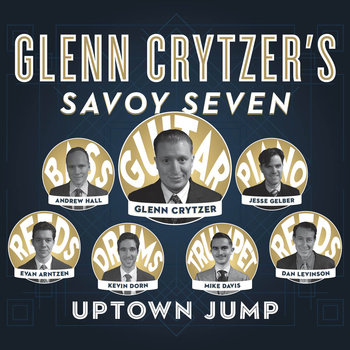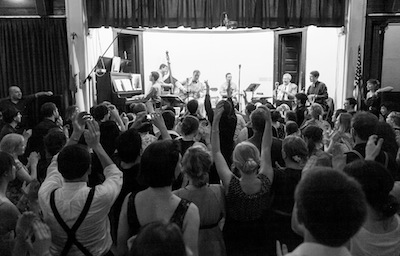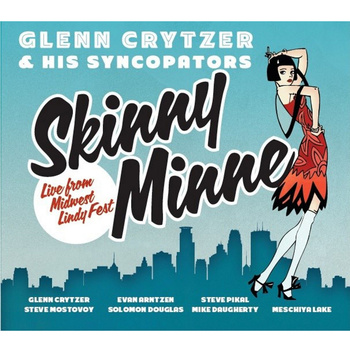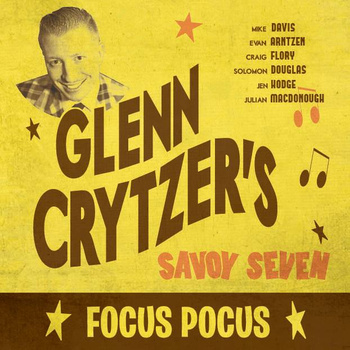Ok, Sydney’s jazz scene is A1.
We have so much live jazz on Sundays that even our huge scene can’t field enough dancers to cover them all. We do all the styles: hot jazz, classic swing later swing easing into bop, NOLA reactionist stuff, NOLA purist stuff, big band swing, small group swing, neoswing, jump blues. One of the best badns I’ve danced to – the Ozcats – is from Sydney. Adrian Cunningham is from Sydney. The scene has a reputation for being quite competitive and kind of seriously Professional, less casual than Melbourne’s more open, friendly scene. But that’s also led to some seriously professional, hardcore jazz acts.
Two of my favourite bands have recently gotten it pretty seriously together. One is Andrew Dickeson’s Blue Rhythm Band, and one is SwingRocket. I’ll talk about the Blue Rhythm Band in this post.
Andrew Dickeson’s Blue Rhythm Band
The Blue Rhythm Band is my current favourite. Band leader Andrew Dickeson is a jazz history nerd and a Basie specialist. He’s also my current favourite drummer (after Lynn Wallis, but then Lynn is everyone’s favourite drummer), and he’s my friend. I’ve been working with Andrew and his band on a number of projects lately, including having them as the house band at the Little Big Band recently. This band understands lindy hoppers, and what we want. So they do it.
They’re so good, they’ve been booked for every major Australian event this year. Yes. MLX, SSF, Sweet n Hot, Canberrang, Jumptown Jam, Little Big Weekend, SLX… and probably more I’ve missed. One of my concerns is that they’ll be over-exposed by all these gigs. Can their repertoire hold up? Can they keep it interesting? Yes.
The rhythm section stays the same, but Andrew uses his serious connects and sound judgement to bring in great talent. These aren’t just a bunch of random musicians, or dancers who’ve been playing instruments for a few years. These are the best musicians in Sydney, with years and years of professional musicianship and national and international tours under their belts. They are fully legit. And they do not compromise this professionalism and ability for dance gigs.
The last party I booked them for, George Washingmachine played violin and it was quite special. Though George does a lot of manouche and western swing, this was solid Ray Nance with Ellington.
The following night they were booked to play another party in the Last Minute Exchange, and I was worried they’d sound a bit samey. But on that night they had Dan Barnett playing trombone (plus a different bass player – a nice guy who was also a tapper!) and it was a completely different sound. Both nights they played Take the A Train, but it was a completely different song each night.
I’ve also booked them to play in a larger formation, with Bob Henderson on trumpet (you can see him playing with Andrew and Brendan in this video), and Dan Barnet on trombone again. Completely different sound and feel.
My ambition is to have the core rhythm section (Peter, Brendan, Andrew) do a skanky barrel house blues session with Brad and perhaps a good, fierce woman shouter on vocals. I’m certain it would make people dance extremely skank.
So what makes the band so great live? We’ve heard all these guys a million times before in different bands. Why do they work so well in this incarnation?
Perhaps most importantly, Andrew’s a strong band leader. The band has a clear focus and direction, guided by Andrew’s leadership, vision, and taste. And he listens when I talk to him about the music dancers like. He thinks about tempo and song length and energy.
But he doesn’t compromise on musicianship. He makes sure the band play music they have strong feels for. When the band sets up on stage (or on the floor, usually :D ), his drums are right in the middle of it all. The other musicians are gathered around, with Brad in the front. This is pretty much as Andrew described the way Basie’s rhythm section working – the bass set down the beat, the guitar added, and then the drums filled in around all that.
Andrew’s not the sort of drummer who pushes things forward. He fills in, letting the bass set the beat. And one of my favourite things is the way he treats his entire kit like a set of percussive instruments. It reminds me of a good NOLA style drummer (like Lynn Wallis :D) where the drummer makes all sorts of sounds. He doesn’t just ride that high hat or bonk on a drum. He makes taps and thwocks and shushes and pings.
I often think of Andrew as the brain or bigger structure of the band, calling solos, songs, etc, as a good band leader should. But Brad Child really brings the feels when he’s in the band. He has a very good ear (heart?) for the feel, the energy of a room. Watching him in the band, I’m reminded of a very good DJ. He knows when to adjust the tempo, or beef up the energy, or back off the chunk. Between him and Andrew, you have a very nice band dynamic. The two work so well together, you don’t get a sense of conflict or competition between two leaders. You really feel as though they have a good, solid collaborative relationship. Andrew listens to Brad’s ideas, and goes with his suggestions. Brad lets Andrew set up the structures and guidelines for the show.
This was really brought home when I saw Dan Barnet sit in with the bigger band for me at Little Big Weekend. Brad and the others had worked with vocalist/lindy hopper Georgia Brooks, and guest tappers Ramona Staffeld and Ryan Campbell-Birch a few times now, and had figured out how we dancers approach the feel of a song. He also clearly realised that Mona and Georgia and Ryan aren’t just ring-ins to be tolerated.
When Ramona got up to tap with the band, there was a moment when Dan was about to come back in after what he clearly thought was Ramona’s ‘turn’, and Brad touched his arm to keep him back. Brad had seen that Ramona was just pausing a moment to listen to the band, before replying. And there was a sudden flash in Dan’s face, as he realised what was going on. Dancers: part of the band. And then he got excited.
It’s this collaboration between dancer and musician that’s really made the Blue Rhythm Band fantastic for us over the last six months or so. These musicians are really, really talented. They know how to work in an improvised band (this is where the riff-based sets come in – they are always improvising within a structure). They know when to back off, to pause so someone can play, when to step up an intensify. And they’ve realised that this is what we do as lindy hoppers too. We know how to jam. We do it within a swing out. Within a jam circle. And I’ve seen these musicians suddenly go, “Ah-HA!” and figure out that we’re not just stooges who’d dance to a metronome. We are jazz dancers.
This relationship has been made clear by (and developed in) having the band play for a jam-style lindy hop comp we held recently for the first time (the Harlem Spoon). We all had to figure out how to do this, both organisers and musicians. Talking to the band after a practice contest before the main event, I was just so delighted when Brad said “Was it ok? I tried to give each of them something to work with.” He just understood that each couple needed a bit of feel or something to work with. They didn’t just want a random drum solo or boring bit of fill.
I can’t help but gush about working with this band. They’ve just fitted into the lindy hop jazz dance vibe like we were meant to be together. Because we were! Having them as the house band at an event with Jenny Deurell and Rikard Ekstrand, and tappers like Ryan Campbell-Birch and Ramona Staffeld, has been wonderful. They’ve talked to these dancers and started seeing that we are really all in the same family. And their lovely cooperative approach to playing as a band has just been the perfect, BEST articulation of the philosophy of dance Jenny and Rikard and Ramona in particular have been teaching. And when we started working with Ryan earlier this year, it all just seemed to click into place: we’re all jazzers. We might embody that in different ways, but we are all working with the same principles, practices, and skills. These are:
- work with other people in collaboration, not antagonism or competition;
- listen, pay attention, don’t just ‘blow your own horn’ all the time :D;
- be prepared to contribute, to speak, to solo, because the second rule of jazz club is: you must jazz;
- learn the physical cues of passing a solo or communicating in jazz – a crooked eyebrow, a cocked ear;
- understand the structure and the ‘rules’ of this game – it’s not chaos or total anarchy;
- be prepared to improvise within this structure. That’s what makes it FUN.
I think that this is why this band is so good: they have figured out that as jazzers, if musicians and dancers work together in an intelligent, creative way, it is the BEST FUN OF ALL TIME. It can really push your art to the next level.
Musicians: Andrew Dickeson (drums), Brendan whatsit (bass), Peter Locke (piano), Brad Child (sax, clarinet).
Style: classic, four on the floor small group swing, riff style (that means they don’t work from scores, and they improvise a lot).
Website: Blue Rhythm Band
Contact: email Andrew on swingishere1234@gmail.com
Recordings: not yet – hassle Andrew for some!
Georgia, Brad, Andrew, Brendan, Peter playing at the chillaxed Sunday party for the Little Big Weekend.





